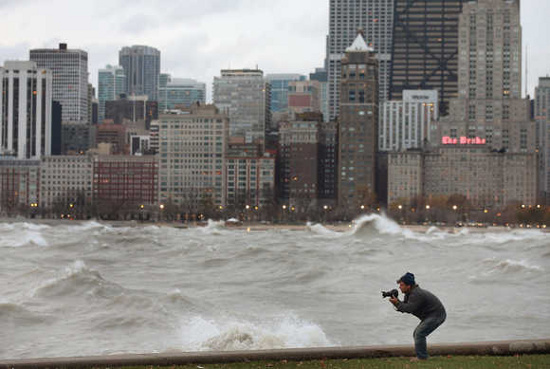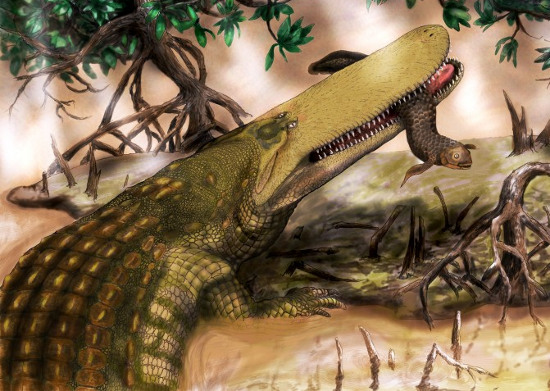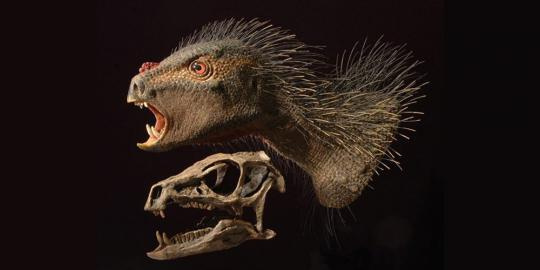Top 10 science stories of 2012
Super hurricane, Mars, God's beads . The field of world science in the past 12 months has passed Time magazine through the most memorable events, stories and discoveries.
1. Super typhoon Sandy and the consequences of climate change

The horrific destruction of Super Hurricane Sandy throughout the northeastern United States last October showed how climate change can cause disasters. More than 100 people were killed, many cities were flooded with floods and more than 8 million people lived in power outages. Scientists all believe that the climate change, especially the rising sea level will make more Sandy appear in the future, with increasing levels of danger.
2. Detecting prehistoric crocodiles

A memorable discovery of this year's archeology is the discovery of the fossilized skull of Aegisuchus witmeri , the crocodile head shield, an ancestral branch of modern crocodile. Researchers speculate that the crocodile lives in Africa about 95 million years ago, with a body length of up to 9m from the tail tip to the nose. In particular, its giant head was 1.5m long. The reason this crocodile is named so is because it has a shield-shaped thick skin just above its head, although this feature is no longer saved on fossil skulls. Experts only envision the existence of the "shield" by analyzing the scars on the bones, along with the blood vessels to feed this shield.
3. Find the Vampire dinosaur

This bizarre dinosaur named Pegomastax africanus was extinct 150 million years ago, but it was not until 2012, after studying the remaining fossils, that the scientific community recognized this as a completely dinosaur strain. new. With a size comparable to that of a cat, P.africanus dinosaurs have a rather ancient image with parrot-like heads and sharp fangs.
4. The moon is considered to be the culprit of sinking Titanic

In a study published in March, two University of Texas physicists accused the moon of being a surprise accomplice in the sinking of the legendary Titanic. According to their hypothesis, right on January 4, 1912, the moon and the sun were aligned with the Earth and their combined gravity caused the tide to fluctuate abnormally. If only this phenomenon is available, sailors are not too strange. But at the same time, the moon at the time of the launch of the Titanic was closest to Earth within 1400 years. And on January 3, the Earth is closest to the sun of the year. Therefore, the waves in the night of 4/1 are not high, but too high compared to the history of hundreds of years. It was the record rise of the sea that liberated many large ice sheets that were stuck on the previous ice island, turning Titanic's voyage into a deadly minefield.
5. Detect nanoparticles in lunar soil
Before NASA astronauts set foot on the moon, the agency knew the moon's land had a special point. Due to the absence of an atmosphere to prevent small meteors from colliding, the moon has suffered numerous bombardments from its universe 4.5 billion years old. Consequently, the surface of the moon is covered with a layer of dust that is even smoother than refined sugar. This dust can fly off the ground when there is an impact and hangs there for a long time, which is not enough to explain the weak gravity of the moon. In 2012, geologist Marek Zbik of Queensland University of Technology (Australia) used a nanotomograph to study a sample of lunar soil brought by Apollo ships. He found these tiny dust particles filled with nanoparticles, a type of electrode that makes the moon's earth tend to float. These particles are still chemically active and capable of binding to electricity, which is why astronauts cannot simply remove them from their uniforms.
6. North Korean satellite falls

The DPRK has spoken loudly with international media about the first attempt to launch a satellite in the country's history. However, according to US and Japanese defense officials, the launch failed. Korean satellites have fallen halfway and broke in the atmosphere. Under the plan, the satellite that North Korea launched was a square weighing about 1000 kg, surrounded on all sides by solar panels and on top with HD cameras. However, the mid-range Unha 3 rocket is more suitable for carrying nuclear warheads than spacecraft.
7. Discovering the ocean on Saturn moon
Located 1.5 billion kilometers from Earth, Saturn's moon Enceladus possesses a giant ocean buried deep beneath its thick ice surface. Because of that, Enceladus possessed strange ice volcanoes and its surface had fractures like stripes on tiger skin. Such a giant ocean water could be a sign of life, if we can find out more.
8. Find out the "Lord's seed"

A new type of particle with 99% of the Higgs elementary particle - or "God's particle" has been discovered by the Large Particle Accelerator (LHC) of the European Atomic Research Organization (CERN). in July 2012. This new type of particle is considered to be the ultimate fundamental particle needed to complete the link chain in the Standard Model of particle physics. CERN claims that this is indeed the heaviest new particle (about 125-165 GeV) compared to the particles that were previously found. However, the organization also cautiously added that new particle data is still in the testing process and will soon have an official conclusion whether this is really "God's seed" or not.
9. Curiosity trains land on Mars

America used to launch an exploration ship on Mars, but none of the projects were large and ambitious by Curiosity, a ship the size of an SUV but worth $ 2.5 billion. Curiosity surpassed 7 minutes of 'horror' to successfully land on the giant wormhole Gale Crater on Mars in August. The whole world held its breath in watching that moment, as well as Curiosity's best act on Red planet ever since. Curiosity has captured many valuable pictures of Mars, obtained the first soil sample for analysis, self-propelled movement and will soon drill Martian rock to study. This project has a formal term of two years and is expected to find traces of microbial life on the red planet.
10. Resignation because 'The county is faster than light'
In 2011, the scientific world in general and physics were shocked when a CERN experiment declared super particles Neutrinos could move faster than light, which was also the theory that Einstein's foundation was wrong.
This announcement immediately faced widespread skepticism from physicists and many tests were conducted later by independent scientists and research groups. By March 16, 2012, CERN had to issue a press release confirming that neutrinos did not move faster than the speed of light, and the reason for the wrong measurement could be due to a loose cable in the experiment. . Professor Antonio Eraditato, Chairman of the OPEERA project, which conducted and announced the "super neutrino particle faster than light" had to resign after the scandal.
- The most bizarre science stories of 2005
- 9 most sexy science stories in 2006
- The most bizarre science stories in 2006
- The 10 least known scientific stories of the year.
- The odd misconceptions in science
- 10 newly discovered scientific mysteries (Part 1)
- Japanese robot writer composed stories of the national contest
- The dark side of science
- Interesting stories about inventions
- The reason people always like to watch stories about sea monsters
- Revenge on March 8
- Patents by farmers
 The most famous scientific failures in history
The most famous scientific failures in history Mysterious genius mechanic and the machine froze time
Mysterious genius mechanic and the machine froze time The son carries the 'bad gene' of genius Albert Einstein
The son carries the 'bad gene' of genius Albert Einstein Isaac Newton
Isaac Newton